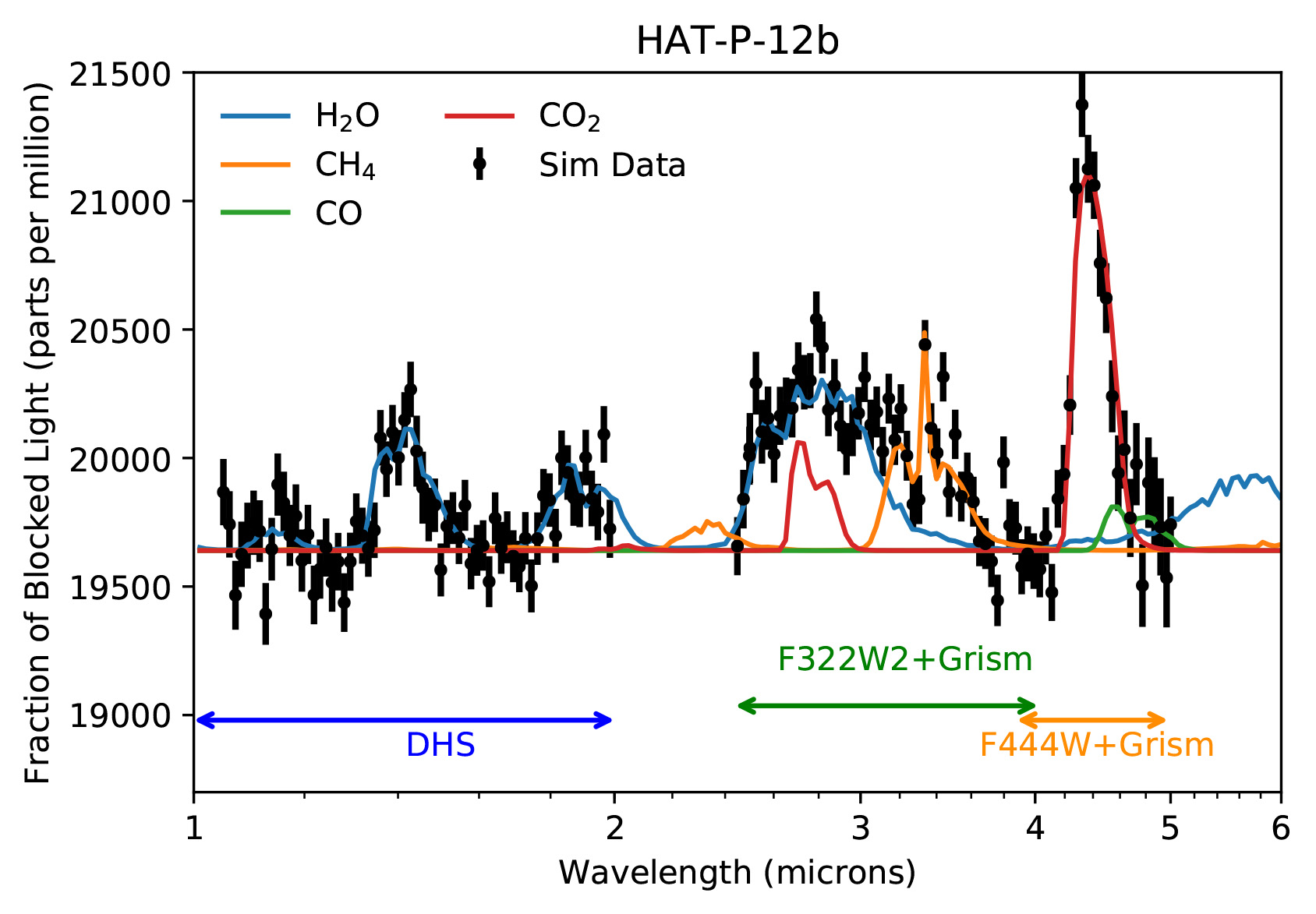Grism Spectroscopy with NIRCam
Although NIRCam is designed as a sensitive camera to take deep, sharp images of the universe, it also has the capability to take medium-resolution (R~1500) spectra of individual objects (e.g., stars, galaxies) using “grisms” in the long-wavelength channel (2.4-5 μm). A grism is a combination of a prism and diffraction grating that spreads light into colors (i.e., a spectrum). When a grism is inserted into the light path, NIRCam will perform as a multi-object spectrometer, producing spectra of many objects simultaneously (Figure X).

Figure X: Simulated NIRCam grism data (Tint = 2 hours) for the blank cosmological field XDF using the F356W filter (one module, covering 2.2’x2.2’, is shown here). The source positions and continuum brightnesses were simulated based on the existing deep HST F160W image. To illustrate the detectability of emission lines at high redshift, [O III] 4959/5007 Å and Hβ lines were inserted assuming z=6 for all sources.
One feature of this observing mode is that it conducts spectroscopy without using slits (i.e., slitless spectroscopy). That is, it acquires spectra for all sources within a given field of view. This makes this mode particularly suited for conducting unbiased searches for objects with strong spectral features, such as high-redshift galaxies with strong emission lines as illustrated in Figure X. By measuring various absorption features in the spectra of stars behind galactic dark clouds, it is also possible to map out the distribution of dust/gas/ice in those dark clouds. In deep integrations, spectra will start to overlap/blend with each other (a drawback of slitless spectroscopy), but each NIRCam module has two grisms with orthogonal dispersion directions, which can be used to mitigate this problem.
In terms of sheer sensitivity, the comparable NIRSpec mode outperforms that of NIRCam grism by a factor of a few, but for some applications, the observer may find the latter mode more advantageous (e.g., there is no need to obtain pre-imaging data with HST or JWST, which is necessary to configure NIRSpec observations). For more detailed discussion of the NIRCam grism slitless spectroscopy mode, see Greene et al (2016).
Studying Extrasolar Atmospheres with NIRCam Grisms
Most of the thousands of planets discovered thus far pass in front of and behind their host stars at some point during their orbits – these are called transiting planets. Each time a transiting planet passes in front of its host star, it creates a silhouette against the star, blocking a fraction of starlight. The larger the planet, the more light is blocked, producing a signature dip in recorded light. Similarly, when the planet passes behind the star, called a secondary eclipse, the star blocks the planet’s light and there is another dip in measured light, albeit much smaller. Transiting planets thus cause tiny winks in a star system’s light that are detectable to very sensitive telescopes.

But it isn’t just the planet that blocks out starlight while transiting; a planet’s atmosphere, too, filters out some of the light when it passes in front of its host star. In addition to filtering out starlight passing through it, a planet’s atmosphere also filters out light radiating from or reflected off of the surface of the planet itself, which can be measured during the secondary eclipse. Planetary atmospheres are composed of many different elements and molecules, which each absorb light at different wavelengths. By studying the spectrum of the light passing through a planet’s atmosphere, astronomers are able to identify which elements and molecules are present in the atmosphere. The atmosphere’s infrared color and brightness also allow astronomers to map the heat in the atmosphere.
Studying the spectra of planetary atmospheres with JWST is made possible with the NIRCam instrument’s grisms. NIRCam’s grisms operate in the infrared portion of the spectrum, the same wavelength range at which many atmospheric gases absorb light.
Near-Infrared Windows into Atmospheres
JWST’s NIRCam instrument has the ability to study planets over a wide range of wavelengths from 1.0 to 5.0 microns. For ground-based telescopes, this wavelength range is heavily obscured by water vapor and other gases, prohibiting precision exoplanet studies. The NIRCam grisms will enable new studies of the carbon content in exoplanet atmospheres, due to the absorption from gases like CH4, CO2 and CO. The figure below shows how each of these gases contribute to the colors of an exoplanet’s atmosphere (here a model for HAT-P-12 b) as light from a star filters through. The coverage of three grism modes for NIRCam is highlighted: the Dispersed Hartmann Sensor (DHS), and long wavelength grism and filter combinations (F322W2 and F444W).

Relevant Publications
Schlawin et al (2018), "Two NIRCam Channels Are Better Than One: How JWST Can Do More Science with NIRCam's Short-Wavelength Dispersed Hartmann Sensor," Publications of the Astronomical Society of the Pacific: NASA ADS
Greene et al (2017), "λ = 2.4 to 5 μm spectroscopy with the James Webb Space Telescope NIRCam instrument," Journal of Astronomical Telescopes, Instruments, and Systems: NASA ADS
Greene et al (2016), "Slitless Spectroscopy with the James Webb Space Telescope Near-Infrared Camera (JWST NIRCam)," Proceedings of the SPIE: NASA ADS
